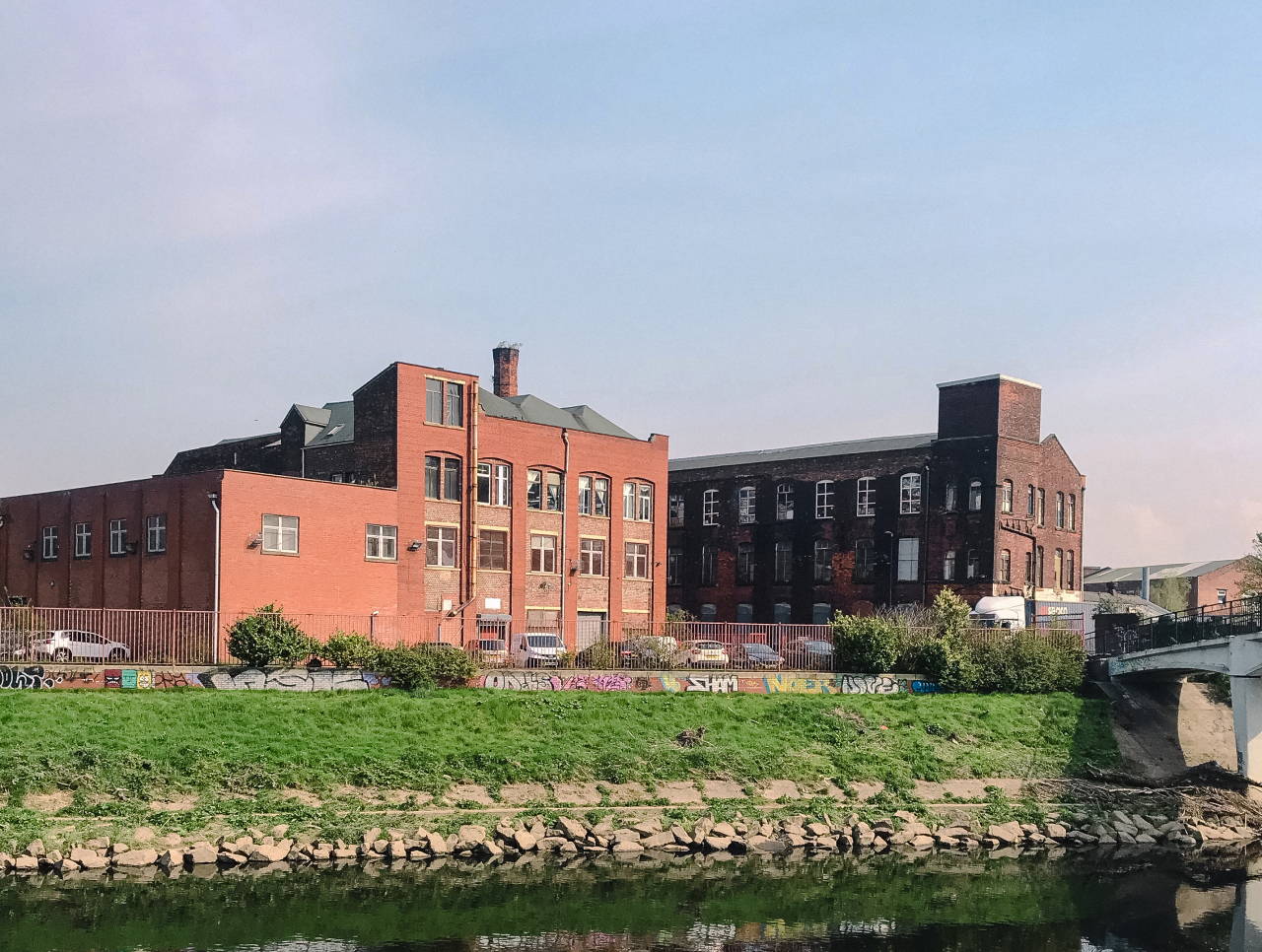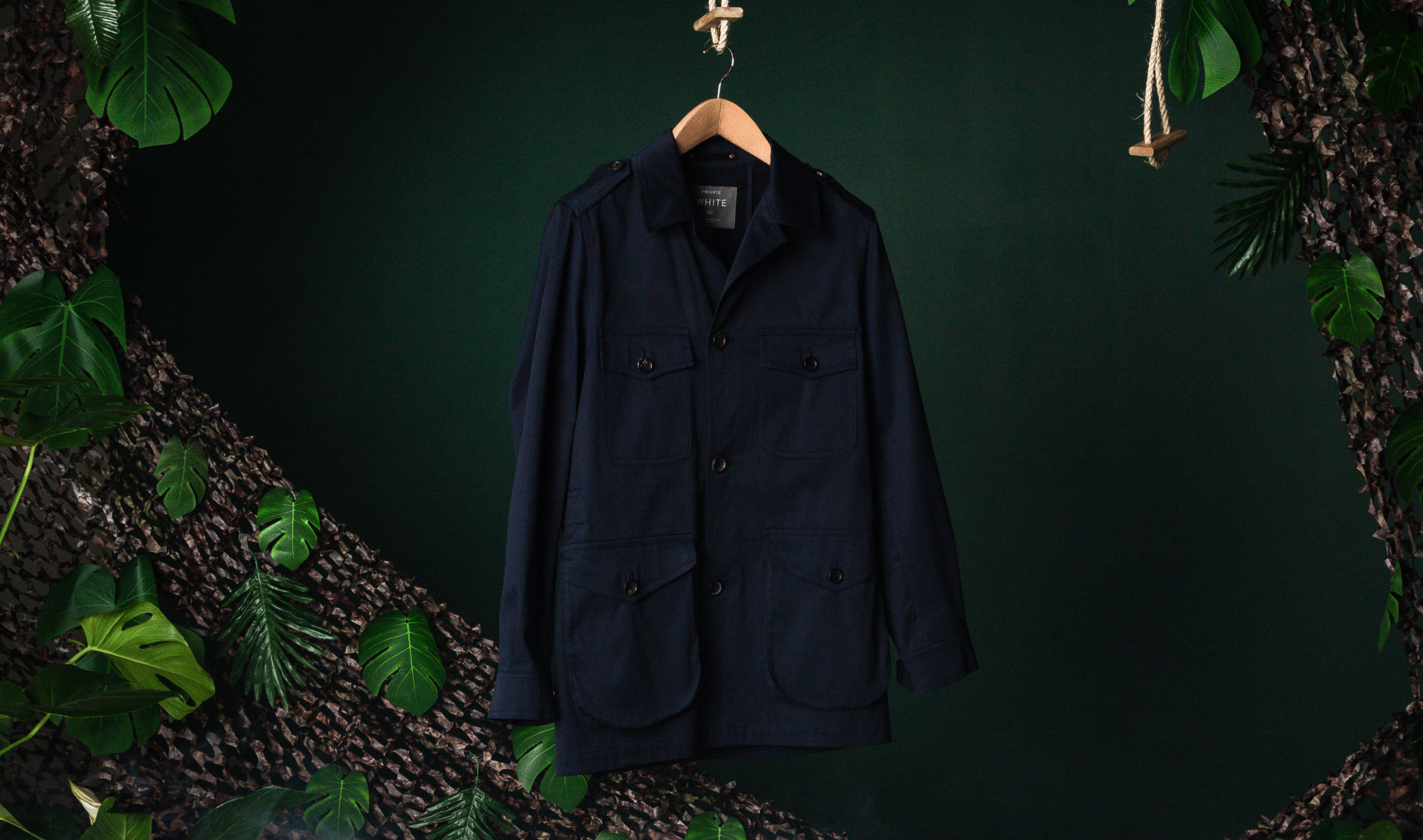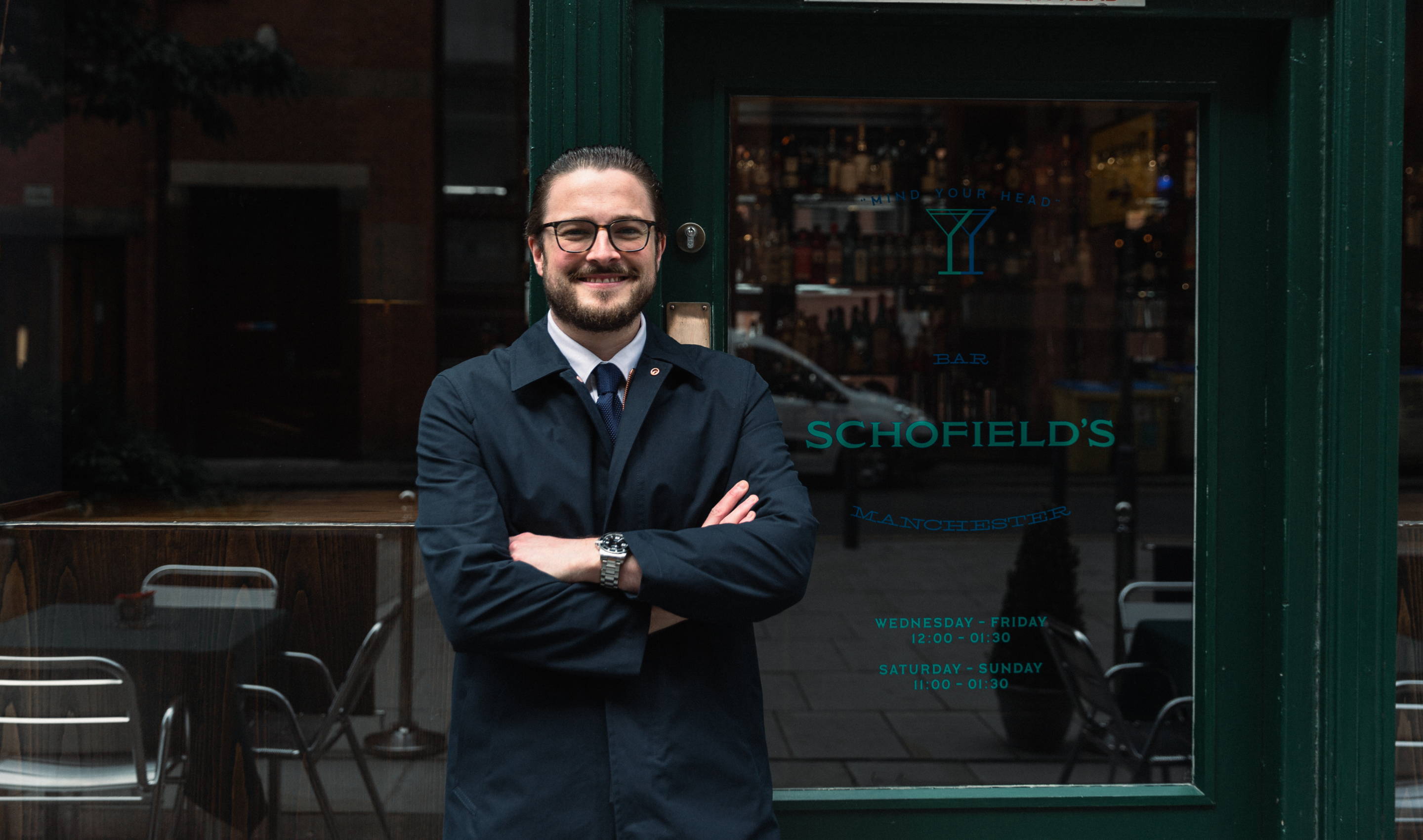JAMES EDEN, CEO & FOUNDER
Words by James Eden
Private White V.C.'s factory in Manchester is more than a place of work - it’s a link to the past. Entwined with the history of both the city and my family, it encapsulates everything the brand is about.
Cottenham House, Private White V.C.’s Manchester factory, is a survivor. With its crenelated roof and red brick walls, it has not been refurbished as apartments with an anodyne name like ‘The Old Works’. Nor has it been turned into offices or storage. It has not become derelict or been demolished. Our factory still does what it did over 150 years ago - it makes things.
This connection with the manufacturing tradition of Manchester is conveyed not only by the quality of our clothes, but also by our own connections with the area. For instance, Managing Director Mike Stoll, who has been a great friend and mentor to me, has been coming here since the early 1970s when he started work as a cutter. As he recalls, the city looked different then: “There were about 70,000 people sewing raincoats in Manchester then and this place was as much in the middle of it as you can get. It was booming - I would walk to work from about a mile and a half away, past factory after factory.”
Tour The Factory
Words by James Eden
Private White V.C.'s factory in Manchester is more than a place of work - it’s a link to the past. Entwined with the history of both the city and my family, it encapsulates everything the brand is about.
JAMES EDEN, CEO & FOUNDER
Cottenham House, Private White V.C.’s Manchester factory, is a survivor. With its crenelated roof and red brick walls, it has not been refurbished as apartments with an anodyne name like ‘The Old Works’. Nor has it been turned into offices or storage. It has not become derelict or been demolished. Our factory still does what it did over 150 years ago - it makes things.
This connection with the manufacturing tradition of Manchester is conveyed not only by the quality of our clothes, but also by our own connections with the area. For instance, Managing Director Mike Stoll, who has been a great friend and mentor to me, has been coming here since the early 1970s when he started work as a cutter. As he recalls, the city looked different then: “There were about 70,000 people sewing raincoats in Manchester then and this place was as much in the middle of it as you can get. It was booming - I would walk to work from about a mile and a half away, past factory after factory.”
THE FACTORY FLOOR
For me, the connection with Cottenham House is even more long-standing. My great grandfather Jack White, in whose honour I named the label, began here as an apprentice after the First World War, ultimately running the place. I remember visiting when I was about 14 or 15. I’d come in the summer or Easter holidays and spend time in the famous factory that Grandpa Jack had been part of. I would do a bit of fabric cutting, sweeping, cleaning, whatever was needed. I found it quite an intimidating place back then.
Our neighbourhood has altered considerably since, but in many ways has always been in a state of flux. I found in the archives at Manchester University numerous maps charting the city’s transformation from a small settlement mentioned in the Domesday book into the world’s leading industrial centre by the 19th and early 20th century. They also give a snapshot of Salford, where we are located. Around 1900 it was a warren of houses, slums and factories producing everything from chocolate to soap, cement to paint and rubber - and, of course, fabric and clothing.
PRIVATE JACK WHITE
THE CUTTING TOOLS
When we start welcoming factory tours again and you can come to visit us, you’ll notice above the door of Cottenham House a sculpture of a hand closed around a bundle of metal. It’s a small, yet significant detail showing the building was, at some time, a wire works. The load bearing strength required for engineering is an asset today, given the size and weight of our machinery. The huge wooden beams in our ceilings mean we can accommodate much heavier equipment, although, unlike a more modern factory, everything is on different floors.
THE CUTTING ROOM
“The huge wooden beams in our ceilings mean we can accommodate much heavier equipment, although, unlike a more modern factory, everything is on different floors.”
JAMES EDEN, CEO & FOUNDER, PRIVATE WHITE V.C.
Aside from a warehouse opposite, almost all the buildings around the Private White V.C. factory have now gone - the Robin Hood pub next door; the old works canteen behind; the rows of densely packed houses. In the 1920s St Simon’s church was pulled down. Before it vanished, the Victorian building was recorded by one of Salford’s most famous sons, the artist L. S. Lowry. From the perspective shown in his 1927 painting Street Scene (St Simon’s Church), now in the nearby Lowry Gallery, he must have sat sketching practically on the doorstep of Cottenham House. It’s intriguing to imagine that one of those figures in the finished picture is Jack White himself, crossing paths with the artist as he leaves work.
STREET SCENE (ST SIMON'S CHURCH) - THE ESTATE OF L.S LOWRY.
PREVIOUS LAND DIAGRAM WHERE PWVC WAS BUILT
One reason for much of the destruction around us was a change to the course of the River Irwell in the 1960s. It now runs next to the factory, but once looped further north meaning our building was well on the opposite bank. Intended to reduce flooding, the move required the wholesale clearance or reconfiguration of entire streets, together with the removal of the massive Anaconda engineering and wireworks. The name survives in one of Manchester’s newest architectural additions, known as Anaconda Cut after the excavations to relocate the river. It is Salford’s tallest building, one of many towers that have sprung up across the skyline. This is an indication of the direction in which the city is now heading, with offices, residential developments and services the future. It is a move away from the past. Those people streaming from their work in the factories represent a vanished way of life, which should be celebrated, but not lamented or sentimentalised.
For me, the connection with Cottenham House is even more long-standing. My great grandfather Jack White, in whose honour I named the label, began here as an apprentice after the First World War, ultimately running the place. I remember visiting when I was about 14 or 15. I’d come in the summer or Easter holidays and spend time in the famous factory that Grandpa Jack had been part of. I would do a bit of fabric cutting, sweeping, cleaning, whatever was needed. I found it quite an intimidating place back then.
Our neighbourhood has altered considerably since, but in many ways has always been in a state of flux. I found in the archives at Manchester University numerous maps charting the city’s transformation from a small settlement mentioned in the Domesday book into the world’s leading industrial centre by the 19th and early 20th century. They also give a snapshot of Salford, where we are located. Around 1900 it was a warren of houses, slums and factories producing everything from chocolate to soap, cement to paint and rubber - and, of course, fabric and clothing.
PRIVATE JACK WHITE
THE CUTTING TOOLS
When we start welcoming factory tours again and you can come to visit us, you’ll notice above the door of Cottenham House a sculpture of a hand closed around a bundle of metal. It’s a small, yet significant detail showing the building was, at some time, a wire works. The load bearing strength required for engineering is an asset today, given the size and weight of our machinery. The huge wooden beams in our ceilings mean we can accommodate much heavier equipment, although, unlike a more modern factory, everything is on different floors.
“The huge wooden beams in our ceilings mean we can accommodate much heavier equipment, although, unlike a more modern factory, everything is on different floors.”
JAMES EDEN, CEO & FOUNDER, PRIVATE WHITE V.C.
THE CUTTING ROOM
Aside from a warehouse opposite, almost all the buildings around the Private White V.C. factory have now gone - the Robin Hood pub next door; the old works canteen behind; the rows of densely packed houses. In the 1920s St Simon’s church was pulled down. Before it vanished, the Victorian building was recorded by one of Salford’s most famous sons, the artist L. S. Lowry. From the perspective shown in his 1927 painting Street Scene (St Simon’s Church), now in the nearby Lowry Gallery, he must have sat sketching practically on the doorstep of Cottenham House. It’s intriguing to imagine that one of those figures in the finished picture is Jack White himself, crossing paths with the artist as he leaves work.
STREET SCENE (ST SIMON'S CHURCH) - THE ESTATE OF L.S LOWRY.
PREVIOUS LAND DIAGRAM WHERE PWVC WAS BUILT
Of course, we at Private White V.C., still in the same premises close to Manchester’s centre, connect to that industrial past. That makes us totally unique: the last remaining working clothing factory in the world’s first industrial city. Our presence in Cottenham House also links us to another aspect of the city that is justly famous - a tradition of creativity, industry and invention. It is this continuity that makes Private White V.C. such an enduring part of the fabric of Manchester.
THE COTTON COLLECTION
One reason for much of the destruction around us was a change to the course of the River Irwell in the 1960s. It now runs next to the factory, but once looped further north meaning our building was well on the opposite bank. Intended to reduce flooding, the move required the wholesale clearance or reconfiguration of entire streets, together with the removal of the massive Anaconda engineering and wireworks. The name survives in one of Manchester’s newest architectural additions, known as Anaconda Cut after the excavations to relocate the river. It is Salford’s tallest building, one of many towers that have sprung up across the skyline. This is an indication of the direction in which the city is now heading, with offices, residential developments and services the future. It is a move away from the past. Those people streaming from their work in the factories represent a vanished way of life, which should be celebrated, but not lamented or sentimentalised.
PRIVATE WHITE V.C. FACTORY (1853 - PRESENT DAY)
PWVC FACTORY DEEDS
Of course, we at Private White V.C., still in the same premises close to Manchester’s centre, connect to that industrial past. That makes us totally unique: the last remaining working clothing factory in the world’s first industrial city. Our presence in Cottenham House also links us to another aspect of the city that is justly famous - a tradition of creativity, industry and invention. It is this continuity that makes Private White V.C. such an enduring part of the fabric of Manchester.
















Leave a comment
This site is protected by hCaptcha and the hCaptcha Privacy Policy and Terms of Service apply.